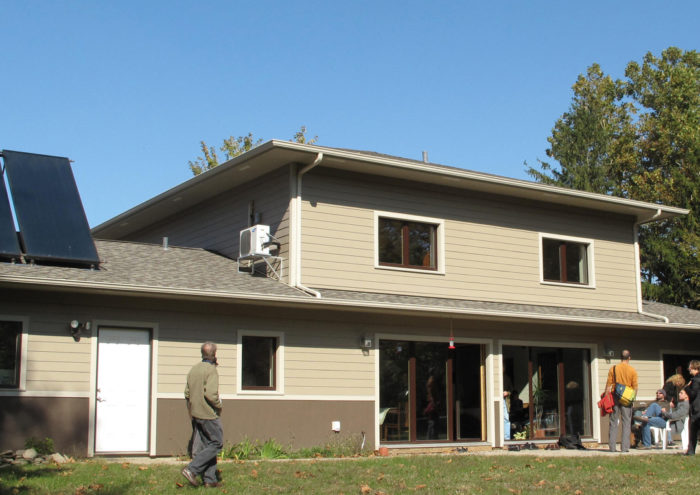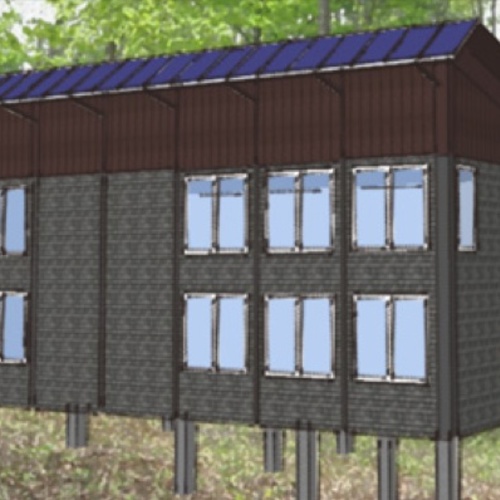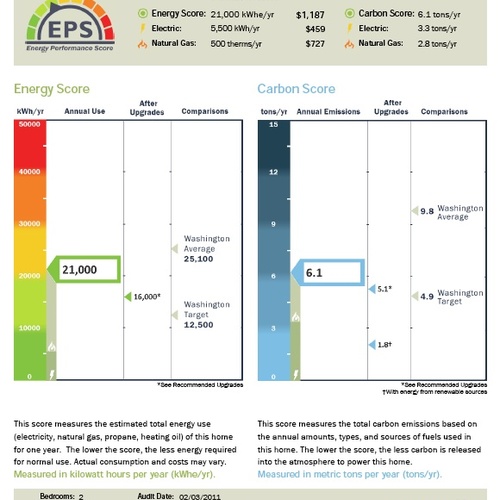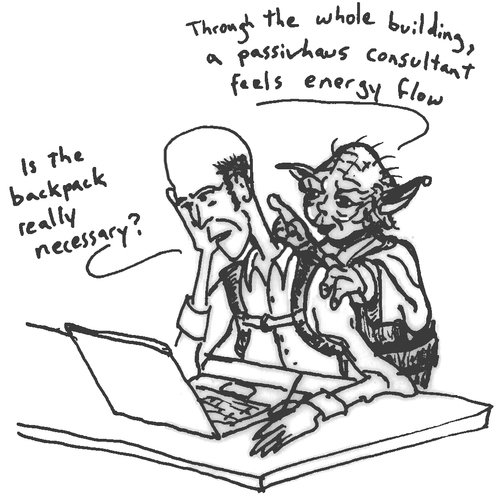
Image Credit: Martin Holladay
Jason Kibbe is in the enviable position of planning the construction of a new house that will be financed entirely by the sale of his current home, leaving him in new digs without a mortgage.
Kibbe plans to swap his 4-bedroom, 2 1/2-bath house in south-central Pennsylvania for a 3-bedroom, 2-bath house of between 1,500 and 1,700 sq. ft, and he’s upfront about his motives:
“I confess my main motive for building is a selfish one,” he writes in a in a Q&A post at GreenBuildingAdvisor. “I’m not looking to spend a ton of cash just to be green, though I certainly don’t mind making some efforts to go in that direction. I primarily want to build an inexpensive house (because I’m cheap) that will have low energy requirements (also because I’m cheap & am concerned about rising energy costs).”
That’s clear enough. But is Kibbe’s best bet a particular kind of high-performance house, one built to the Passivhaus standard, or a more universal design relying on general passive solar principles?
Houses built to the Passivhaus standard must meet very stringent requirements for air infiltration and energy use. As such, they occupy a special corner of the high-performance building world, not only in energy efficiency but often in the cost of construction as well. Passive solar houses can be highly efficient, but the term in itself is vague.
When Kibbe wrote, “I wish there was a repository of building plans and suggested materials for use in a passive house,” it was unclear whether he had a Passivhaus or a passive solar house in mind. “I’ve been gleaning information from this site and others, but still struggle with what are the ‘best’ heating (radiant floor, heat pump, etc.), HRV, (brand, specs.…
Weekly Newsletter
Get building science and energy efficiency advice, plus special offers, in your inbox.

This article is only available to GBA Prime Members
Sign up for a free trial and get instant access to this article as well as GBA’s complete library of premium articles and construction details.
Start Free TrialAlready a member? Log in















19 Comments
Martin's recs might already be close to Passivhaus
J Chestnut also mentioned that Martin's recommendations might meet Passivhaus in zone 5, which jives with what we're noticing as well. E-W orientation while maintaining a compact volume, using the right windows/glazing and R-20/40/60 could be dead on.
Radiant Floor Worth it?
In this article Martin said, "Martin mentioned hydronic tubing in passing with respect to the basement slab; radiant floor distribution is expensive and any dollars spent on this type of system would be much better placed in other mechanicals or the envelope.
Today I visited a passive solar Durisol house I built several years back, and the owners said they do not turn on the radiant, it's too expensive. We are in Southern Oregon and they were spending at least $250/month on their electric running the system, even in this climate. They have solar hot water, PV panels, and wood stove, and are Net Zero leaving the radiant off. Valuable info. Truly, for them wanting to be energy independent, the money would have been better spent elsewhere.
Response to Matthew Amann
Matthew,
I agree that the electrical load (for circulating pumps) of radiant-floor systems can be significant, especially for systems that are designed for continuous circulation. That's why off-grid homeowners usually can't install a radiant floor -- these systems are energy hogs from an electrical perspective.
"Passive House" Please
Scott, I vote for “Passive House” and thank you for writing “Passivhaus” to distinguish this European movement from our own, but read on. Much like the information presented in the article “Practical Solar Design” that we worked together on in the Oct/Nov issue of Fine Homebuilding, the basic concepts of passive solar homes remains the same. The standards for a home’s envelope (insulation and air tightness) have become more stringent, but the concepts of glass location, building shape, thermal mass and proper overhang design remains the same. I like these definitions that were home-grown in the U.S. from the earlier Passive Solar Guidelines for Builders (see posting #28 on Martin’s Superinsulated House Specs) although I think they should have said for “designers”.
Although on one hand I was excited to see the introduction of the Passivhaus in the United States, I could not help but become slightly concerned about the further muddying of passive solar waters. It seems that I am still trying to help consumers overcome the stereotypical impression of passive solar from the 1970’s that was too contemporary for most people’s tastes and now we have another element to explain. I cannot comment on the fine details of the Passivhaus standards I am not certified, (the workshops are typically far away, last three days, and often are not on consecutive days) but I do more and more often create specifications for the passive solar homes that we design to be closely aligned with the Passivhaus philosophy. (See the Colorado home referenced in the above mentioned posting.)
In any case, according to an email announcement I just received, Passive House is here to stay. Perhaps we should start referring to it as PHIUS instead of Passivhaus.
“RESNET Enters Into Strategic Partnership with the Passive House Institute US -
RESNET and the Passive House Institute US (PHIUS) have entered into an agreement that synchronizes standards, modeling, quality assurance and quality control for low energy homes and buildings.”
http://www.resnet.us/blog/resnet-enters-into-strategic-partnership-with-the-passive-house-institute-us/
What I really hope is that the designers of software will now be paying more attention to passive solar gains. The last time I tried the latest versions of the two most popular software programs used by HERS raters, I was disappointed to see that rotating a building with south glass did not accurately reflect the passive solar implications. Plus it’s a shame that Home Energy Raters have to continuously apologize to my clients that their software does not adequately show the passive solar gains and the overall energy bills for heating will actually be less, with little cooling penalty with the properly placed and shaded glass.
Debbie Coleman, Architect, Sun Plans
All climate zones in North America
3rd Party Certification before HERS-ay
First off, Debbie is completely right about the flawed HERS modeling software. It is a flawed rating system in general and I'm glad to see new energy labels emerging despite the iron curtain of RESNET. This is a good one- http://energy-performance-score.com/
Secondly, I'm surprised GBA actually published the line about not paying for Passive or LEED certification and hiring a HERS rater as an alternative. We all know there are great builders who are capable of building fantastic homes but 95% of the time, this is far from the case. Even if you hire the best passive solar designer, it doesn't mean that translated into a building that performs to a Passive standard. The point of 3rd-Party rating systems is they make sure everything that is supposed to be done is done.
Getting a home to test out at 0.6 ACH (Passive standards) is no easy task and a HERS rater will not help you achieve this. Nor will a HERS rater be able to offer any valuable advice except, "Install and Energy Star this," or "you might want to beef up that insulation."
From my experience, most 3rd-party green building certifiers are HERS Raters. So you may as well go the full certification route and get a HERS rating. Unless you keep detailed utility records, good luck proving your home is built green for resale purposes.
clarification
please indulge me - the 70 degree SoCal winters have softened my brain...:)
double-wall 2x4s or you mean 2x6s?
also - heat pump in Pennsyvania winter? Is it somehow incorporated with the HRV (how without ducts)? I thought the heat pumps kick on electric preheat once you get below 30F or so...
Response to Brenden McEneaney
Brendan,
Q. "Heat pump in Pennsyvania winter? Is it somehow incorporated with the HRV (how without ducts)?"
A. No, ductless minisplits are not integrated with HRVs.
Q. "Heat pump in Pennsyvania winter? ... I thought the heat pumps kick on electric preheat once you get below 30°F or so."
A. No, the Mitsubishi Hyperheat is much more sophisticated than air-source heat pumps made by U.S. manufacturers. The Mitsubishi can operate down to -13°F without any electric resistance heat. It is a true cold-climate air-source heat pump.
The envelope please.
The homes I build have lots of wood. It's often on the floors, walls, and even ceilings, but never in the walls for several reasons. First, wood walls can degrade. Second, wood walls (especially with cellulose) can be an attraction for termites and ants. Third, wood walls have a very low thermal mass which doesn't contribute to effective energy efficiency. Fourth, the cost of wood walls is not less than ICF (insulated concret form) construction nor is the return on investment as high. Yes, some ICF homes will cost more than the double wood wall home, but not all. Variables affecting cost are include the speed of installation, the price of the ICF, and the amount of concrete, rebar, bracing required, and labor costs. These are variables, thus the cost of an ICF home varies. The rule of thumb one hears is that ICF homes cost $2 to $5 dollars a square foot more than conventional construction. The rule of thumb is an average of ICF construction costs. Not all ICFs cost several dollars a square foot more. A builder or future homeowner needs to compare several different ICFs to the cost of wood frame rather than to the average, or just a single ICF, cost.
I'm don't believe this world can afford to continue building wood frame homes that don't last for the centuries. I don't know the estimated life span of a house built today, but not many years ago the life expectancy of a wood frame house was 60 years.
The homes I build wil last for generation after generation, and are guaranteed to be 50% to 70% more energy efficient than standard wood frame homes. Adding more wood and cellulose won't offer that kind of efficiency, that kind of longevity, or offer that kind of savings.
PassivHaus vs Passive Solar House
I've designed and built a variety of energy efficient homes since the mid 70's and have a couple of suggestions.
First, let me first urge Jason to be very careful mixing the two types of design types. The danger is in combining high insulation levels, too much solar glazing, and insufficient thermal mass. The result can be daytime overheating and excessive glare. I've seen lots of houses where the south glazing is covered with window coverings all the time. When you reach Passiv Haus insulation levels, very little solar glazing is required. This problem is the main reason, not overall heating bills, that good software and an experienced designer are essential.
An understanding of the climate AT the building site is also important. If the climate is cloudy, then err towards Passiv Haus. If consistently sunny, then Passive Solar can't be beat. Good software should help with this issue.,
Finally, one of the downsides of high insulation levels and small windows is the isolation set up between homeowners and the natural environment. I insulated the hell out of my attic this winter and it feels really dead upstairs. Personally I really enjoy how light and shadow, and the sound of wind and birds can enliven the inside of a home and a good design will enhance that experience.
Thanks for the great question and the knowledgable responses.
summertime overheating
i don't see any issues mixing the two. Passivhaus takes passive solar and kicks it up a notch. the Passivhaus modeling software already takes into account overheating due to high levels of insulation, SHGC and thermal mass. and when your building is as tuned as a Passivhaus, then 5/8" GWB is considered thermal mass - potentially saving oodles of CO2 emissions over concrete slabs/walls.
i'm not really sure what 'Passivhaus insulation levels' are, as PH insulation levels vary by location (san diego is code minimum or less - fairbanks, not so much), designer's approach, glazing, orientation, etc.
two designers working in the exact same city can have very different levels of insulation required to achieve the Passivhaus standard.
also, to reach Passivhaus does not mean you have very little solar glazing - in most cases, it's the exact opposite (at least in most of the EU projects) - loading up the south with high performance/high SHGC windows, which can also reduce the amount of insulation needed. i don't know many Passivhaus designers (not consultants - there is a bit of a difference) advocating for tiny windows.
Response to Rick Hansen
Rick,
You wrote, "Wood walls (especially with cellulose) can be an attraction for termites and ants." Actually, ant problems are more associated with walls with rigid foam (including ICF walls). Ants love rigid foam.
You wrote, "Wood walls have a very low thermal mass which doesn't contribute to effective energy efficiency." In most climates, the thermal mass of a wall is irrelevant to its thermal performance.
You wrote, "The cost of wood walls is not less than ICF." I disagree, and almost every builder who has done cost comparisons also disagrees. Your opinion appears to be colored by the fact that you are an ICF dealer or ICF builder.
Double Stud Walls
Forgive me if this has been covered elsewhere in GBA. How do double stud walls filled with cellulose w/ no vapor barriers or exterior insulation board prevent internal wall condensation? Is it because the packed cellulose is a vapor barrier and prevents inside humidity from migrating outward toward the cold line within the wall?
Response to Michael Roland
Michael,
Q. "How do double stud walls filled with cellulose w/ no vapor barriers or exterior insulation board prevent internal wall condensation?"
A. This is a big issue, but briefly (a) building codes don't require vapor barriers, only vapor retarders, and (b) the use of interior vapor barriers slows the drying of wall assemblies to the interior during summer months, and therefore interior vapor barriers are not recommended outside of extremely cold climates or unusual rooms like indoor swimming facilities.
For more information, see:
Vapor Retarders and Vapor Barriers
Forget Vapor Diffusion — Stop the Air Leaks!
How Risky Is Cold OSB Wall Sheathing?
Q. "Is it because the packed cellulose is a vapor barrier?"
A. No. Cellulose is not a vapor barrier.
Response to Michael Roland
I believe the reason that vapor diffusion doesn't condensate and cause damage (in a double stud wall filled with dense pack cellulose) is due to the fact that although the vapor(in my climate) is moving from inside to outside, and due to the extremely hydrophilic properties of the cellulose, the vapor is not "dense" enough to condensate when it finally reaches the inside face of the sheathing. I believe that absorption and diffusion is the best way to avoid problems with any wall assembly, IMO.
A practical Passivhaus?
John Brooks asks for an example of a practical Passivhaus. The CoreHaus was built in Portland, OR as a spec house with an asking price similar to other new construction in the area and it sold before completion. The costs were kept reasonable through a simple, compact envelope, standard building practices (2x8 framing with exterior foam insulation), and a simple mechanical system. The result is a modern, comfortable, healthy home with affordable utility bills... seems pretty practical to me. http://www.corehauspdx.com
Looks Nice
Robert Hawthorne,
I like the floor plan and the look
I like the plywood air barrier and the NO Garage
What was the sales price not including land?
CoreHaus sales price
John,
Thanks for the comments. Subtracting the value of the lot, the CoreHaus sold for about $160/SF.
ICF vs wood frame
Martin, or anyone else,
You mentioned that ants like rigid foam and that ICF costs more, but could you comment on the relative cost, insulation value and the longevity component of ICF vs the double wall wood frame with cellulose that you seem to be recommending? Here in Florida where we have hurricanes, termites, and hot, humid weather (increased dry rot) ICF's look pretty good. Isn't the greenest building one that lasts longer and needs less maintenance over it's lifetime? Thanks.
Response to Kurt Johnsen
Kurt,
I agree with your basic point that the best wall assembly will vary by climate. I don't have much experience with termites, but I can see the attraction of concrete walls in termite-infested areas.
There is no single answer to the question, "What's the best wall assembly?" The answer depends on local conditions.
Log in or become a member to post a comment.
Sign up Log in